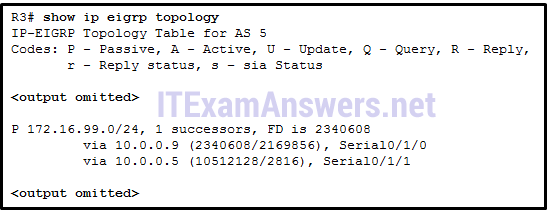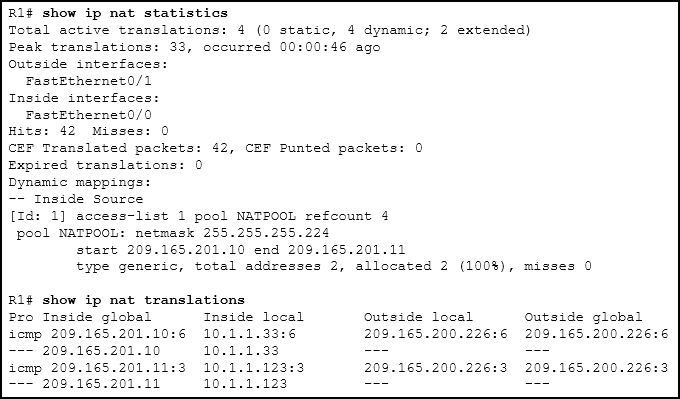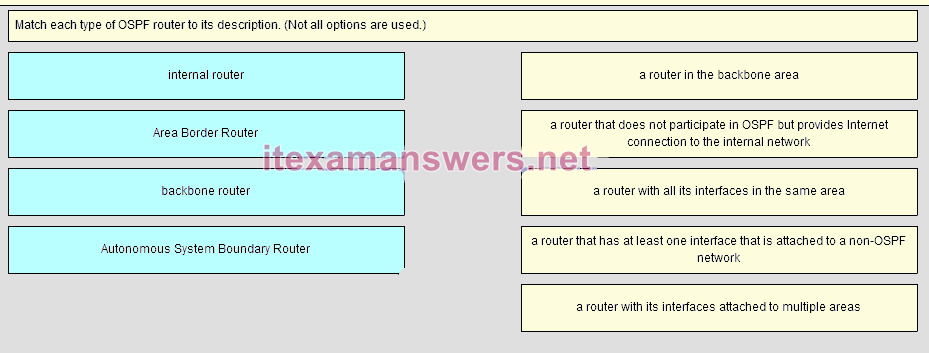1. Refer to the exhibit. Which two networks contain feasible successors? (Choose two.)

- 10.44.100.252
- 10.44.101.252
- 192.168.71.0
- 192.168.51.0
- 10.44.104.253
2. Which three metric weights are set to zero by default when costs in EIGRP are being calculated? (Choose three.)
- k5
- k6
- k2
- k4
- k3
- k1
3. What information does EIGRP maintain within the routing table?
- only successors
- all routes known to the router
- only feasible successors
- both successors and feasible successors
- adjacent neighbors
4. Which configuration is necessary to ensure successful operation of EIGRP for IPv6?
- The eigrp router-id command requires an IPv6 address within the router configuration mode.
- The network command is required within the router configuration mode.
- The no shutdown command is required within the router configuration mode.
- The router eigrp autonomous-system command is required within the router configuration mode.
5. Fill in the blank.In an EIGRP topology table, a route that is in a/an ________ state will cause the Diffusing Update Algorithm to send EIGRP queries that ask other routers for a path to this network.
Correct Answer: active
6. Refer to the exhibit. R2 has two possible paths to the 192.168.10.4 network. What would make the alternate route meet the feasibility condition?

- a reported distance less than 3523840
- a reported distance greater than 41024000
- a feasible distance greater than 41024000
- an administrative distance less than 170
7. Fill in the Blank. Use the abbreviation.
EIGRP uses the protocol ______ to deliver EIGRP packets to neighbors.
Correct Answer: RTP*
8. What is identified within the opcode of an EIGRP packet header?
- the EIGRP sum of delays from source to destination
- the EIGRP hold timer agreed upon with a neighbor
- the EIGRP message type that is being sent or received from a neighbor
- the EIGRP autonomous system metrics
9. Which table is used by EIGRP to store all routes that are learned from EIGRP neighbors?
- the adjacency table
- the routing table
- the topology table
- the neighbor table
10. When an EIGRP-enabled router uses a password to accept routes from other EIGRP-enabled routers, which mechanism is used?
- Reliable Transport Protocol
- partial updates
- EIGRP authentication
- bounded updates
- Diffusing Update Algorithm
11. Which destination MAC address is used when a multicast EIGRP packet is encapsulated into an Ethernet frame?
- 01-00-5E-00-00-09
- 01-00-5E-00-00-10
- 01-00-5E-00-00-0A
- 01-00-5E-00-00-0B
12. What is the purpose of using protocol-dependent modules in EIGRP?
- to describe different routing processes
- to identify different application layer protocols
- to accommodate routing of different network layer protocols
- to use different transport protocols for different packets
13. If all router Ethernet interfaces in an EIGRP network are configured with the default EIGRP timers, how long will a router wait by default to receive an EIGRP packet from its neighbor before declaring the neighbor unreachable?
- 10 seconds
- 15 seconds
- 20 seconds
- 30 seconds
14. Which command or commands must be entered on a serial interface of a Cisco router to restore the bandwidth to the default value of that specific router interface?
- shutdown
no shutdown - bandwidth 1500
- copy running-config startup-config
reload - no bandwidth
15. Which two factors does an EIGRP router use to determine that a route to a remote network meets the feasible condition and is therefore loop-free? (Choose two.)
- the feasible distance on the local router
- the reported distance on a neighbor router
- the administrative distance on the remote router
- the successor route on a neighbor router
- the feasible successor route on the remote router
16. Why would a network administrator use a wildcard mask in the network command when configuring a router to use EIGRP?
- to exclude some interfaces from the EIGRP process
- to send a manual summarization
- to lower the router overhead
- to subnet at the time of the configuration
17. Refer to the exhibit. R3 has two possible paths to the 172.16.99.0 network. What is the reported distance of the feasible successor route?

- 2340608
- 2169856f
- 2816
- 10512128
18. What protocol is use by EIGRP to deliver EIGRP packets to neighbors?
- UDP
- TCP
- RTP
- DTP
19. Which condition will cause DUAL to put an EIGRP route into the active state?
- The successor and feasible successor are both available.
- The successor is available but there is no feasible successor.
- The successor is no longer available but there is a feasible successor.
- The successor is no longer available and there is no feasible successor.
20. Which statement describes a characteristic of the delivery of EIGRP update packets?
- EIGRP sends all update packets via multicast.
- IGRP sends all update packets via unicast.
- EIGRP uses a reliable delivery protocol to send all update packets.
- EIGRP uses UDP to send all update packets.
21. An administrator issues the router eigrp 100 command on a router. What is the number 100 used for?
- as the length of time this router will wait to hear hello packets from a neighbor
- as the number of neighbors supported by this router
- as the autonomous system number
- as the maximum bandwidth of the fastest interface on the router
22. Which two EIGRP packet types are sent with unreliable delivery? (Choose two.)
- query
- update
- hello
- acknowledgment
- reply
23. A network administrator wants to verify the default delay values for the interfaces on an EIGRP-enabled router. Which command will display these values?
- show running-config
- show ip protocols
- show interfaces
- show ip route
24. Open the PT Activity. Perform the tasks in the activity instructions and then answer the question. Which code is displayed on the web server?

- Done
- IPv6
- EIGRP
- Complete
- EIGRP
25. A new network administrator has been asked to verify the metrics that are used by EIGRP on a Cisco device. Which two EIGRP metrics are measured by using static values on a Cisco device? (Choose two.)
- load
- reliability
- bandwidth
- MTU
- delay
26. Order the precedence in which an EIGRP router would choose the router ID. (Not all options are used.)

27. Match the correct version of EIGRP with the EIGRP features. (Not all options are used.)

Older Version
28. Which statement describes a multiarea OSPF network?
- It consists of multiple network areas that are daisy-chained together.
- It requires a three-layer hierarchical network design approach.
- It has a core backbone area with other areas connected to the backbone area.
- It has multiple routers that run multiple routing protocols simultaneously, and each protocol consists of an area.
29. What is one advantage of using multiarea OSPF?
- It allows OSPFv2 and OSPFv3 to be running together.
- It enables multiple routing protocols to be running in a large network.
- It increases the routing performance by dividing the neighbor table into separate smaller ones.
- It improves the routing efficiency by reducing the routing table and link-state update overhead.
30. Which characteristic describes both ABRs and ASBRs that are implemented in a multiarea OSPF network?
- They usually have many local networks attached.
- They both run multiple routing protocols simultaneously.
- They are required to perform any summarization or redistribution tasks.
- They are required to reload frequently and quickly in order to update the LSDB.
31. An ABR in a multiarea OSPF network receives LSAs from its neighbor that identify the neighbor as an ASBR with learned external networks from the Internet. Which LSA type would the ABR send to other areas to identify the ASBR, so that internal traffic that is destined for the Internet will be sent through the ASBR?
- LSA type 1
- LSA type 2
- LSA type 3
- LSA type 4
- LSA type 5
32. Which two statements correctly describe OSPF type 3 LSAs? (Choose two.)
- Type 3 LSAs are known as autonomous system external LSA entries.
- Type 3 LSAs are generated without requiring a full SPF calculation.
- Type 3 LSAs are used for routes to networks outside the OSPF autonomous system.
- Type 3 LSAs are known as router link entries.
- Type 3 LSAs are used to update routes between OSPF areas.
33. Refer to the exhibit. What can be concluded about network 192.168.4.0 in the R2 routing table?

- The network was learned from a router within the same area as R2.
- The network was learned through summary LSAs from an ABR.
- The network can be reached through the GigabitEthernet0/0 interface.
- This network should be used to forward traffic toward external networks.
34. A network administrator is verifying a multi-area OSPF configuration by checking the routing table on a router in area 1. The administrator notices a route to a network that is connected to a router in area 2. Which code appears in front of this route in the routing table within area 1?
- C
- O
- O E2
- O IA
35. Which three steps in the design and implementation of a multiarea OSPF network are considered planning steps? (Choose three.)
- Verify OSPF.
- Configure OSPF.
- Define the OSPF parameters.
- Gather the required parameters.
- Troubleshoot the configurations.
- Define the network requirements.
36. A network administrator is implementing OSPF in a portion of the network and must ensure that only specific routes are advertised via OSPF. Which network statement would configure the OSPF process for networks 192.168.4.0, 192.168.5.0, 192.168.6.0, and 192.168.7.0, now located in the backbone area, and inject them into the OSPF domain?
- r1(config-router)# network 192.168.0.0 0.0.0.255 area 1
- r1(config-router)# network 192.168.4.0 0.0.3.255 area 1
- r1(config-router)# network 192.168.4.0 0.0.15.255 area 1
- r1(config-router)# network 192.168.0.0 0.0.3.255 area 0
- r1(config-router)# network 192.168.4.0 0.0.3.255 area 0
- r1(config-router)# network 192.168.4.0 0.0.255.255 area 0
37. The network administrator has been asked to summarize the routes for a new OSPF area. The networks to be summarized are 172.16.8.0, 172.16.10.0, and 172.16.12.0 with subnet masks of 255.255.255.0 for each network. Which command should the administrator use to forward the summary route for area 15 into area 0?
- area 0 range 172.16.8.0 255.255.255.248
- area 0 range 172.16.8.0 255.255.248.0
- area 15 range 172.16.8.0 255.255.248.0
- area 15 range 172.16.8.0 255.255.255.248
38. Which two networks are part of the summary route 192.168.32.0/22? (Choose two.)
- 192.168.31.0/24
- 192.168.33.0/24
- 192.168.37.0/24
- 192.168.35.0/24
- 192.168.36.0/24
- 192.168.38.0/24
39. Where can interarea route summarization be performed in an OSPF network?
- ASBR
- DR
- ABR
- any router
40. Refer to the exhibit. What is indicated by the O IA in the router output?

- The route was manually configured.
- The route was learned from within the area.
- The route was learned from outside the internetwork.
- The route was learned from another area.
41. Refer to the exhibit. Which two statements are correct? (Choose two.)

- The entry for 172.16.200.1 represents a loopback interface.
- The routing table contains routes from multiple areas.
- To reach network 172.16.2.0, traffic will travel through the GigabitEthernet0/0 interface.
- The routing table contains two intra-area routes.
- To reach network 192.168.1.0, traffic will exit via the Serial0/0/0 interface.
42. Which command can be used to verify the contents of the LSDB in an OSPF area?
- show ip ospf database
- show ip ospf interface
- show ip ospf neighbor
- show ip route ospf
43. Fill in the blank.
The backbone area interconnects with all other OSPF area types.
44. Fill in the blank. Do not use acronyms.
OSPF type 2 LSA messages are only generated by the designated router to advertise routes in multiaccess networks.
45. Fill in the blank. Use a number.
An ASBR generates type 5 LSAs for each of its external routes and floods them into the area that it is connected to.
46. Refer to the exhibit. Fill in the blank. Do not use abbreviations.
The network 192.168.10.128 0.0.0.127 area 1 command must be issued to configure R1 for multiarea OSPF.
47. Why do OSPF serial interfaces usually require manual bandwidth configuration?
- OSPF uses the bandwidth value to compute routes for its routing table.
- Each side of an OSPF serial link should be configured with a unique value.
- All serial interfaces default to a value of 1.544 Mb/s.
- Bandwidth value affects the actual speed of the link.
48. What is used to facilitate hierarchical routing in OSPF?
- autosummarization
- the use of multiple areas
- frequent SPF calculations
- the election of designated routers
49. What OSPF LSA type is used to inform routers of the router ID of the DR in each multiaccess network in an OSPF area?
- type 1
- type 2
- type 3
- type 4
50. What type of OSPF LSA is originated by ASBR routers to advertise external routes?
- type 1
- type 2
- type 3
- type 5
51. What routing table descriptor is used to identify OSPF summary networks that originate from an ABR?
- O
- O IA
- O E1
- O E2
52. Refer to the exhibit. After attempting to enter the configuration that is shown in router RTA, an administrator receives an error and users on VLAN 20 report that they are unable to reach users on VLAN 30. What is causing the problem?

- Dot1q does not support subinterfaces.
- There is no address on Fa0/0 to use as a default gateway.
- RTA is using the same subnet for VLAN 20 and VLAN 30.
- The no shutdown command should have been issued on Fa0/0.20 and Fa0/0.30.
53. Refer to the exhibit. A network administrator has been asked to summarize the networks shown in the exhibit as part of a multiarea OSPF implementation. All addresses are using a subnet mask of 255.255.255.0. What is the correct summarization for these eight networks?

- 10.0.4.0 255.255.0.0
- 10.0.0.0 255.255.240.0
- 10.0.4.0 255.255.248.0
- 10.0.8.0 255.255.248.0
54. Open the PT Activity. Perform the tasks in the activity instructions and then answer the question. Fill in the blank. Do not use abbreviations. What is the missing command on router R2 to establish an adjacency between routers R1 and R3?
network 172.16.10.0 0.0.0.255 area 0 *
55. Match each type of OSPF router to its description. (Not all options are used.)


Place the options in the following order:
backbone router-> a router in the backbone area
– not scored –
internal router -> a router with all its interfaces in the same area
Autonomous System Boundary Router -> a router that has at least one interface that is attached to a non-OSPF network
Area Border Router -> a router with its interfaces attached to multiple areas
56. Launch PT Hide and Save PT
 Open the PT Activity. Perform the tasks in the activity instructions and then answer the question. What is preventing users who are connected to router R2 from accessing resources located either within the network 192.168.1.0 or the internet?
Open the PT Activity. Perform the tasks in the activity instructions and then answer the question. What is preventing users who are connected to router R2 from accessing resources located either within the network 192.168.1.0 or the internet?
- The router R2 is not receiving any updates from either router R1 or R3.
- The default route is not redistributed correctly from the router R1 by OSPF.
- The OSPF timers that are configured on routers R1, R2, and R3 are not compatible.
- The interface that is connected to the ISP is down.
- The OSPF network statements are misconfigured on one of the routers.
Download PDF File below:

new question
The picture for: Refer to the exhibit. R2 has two possible paths to the 192.168.10.4 network. What would make the alternate route meet the feasibility condition? has changed to the following
Fixed, many thanks for your report!!